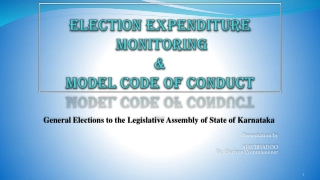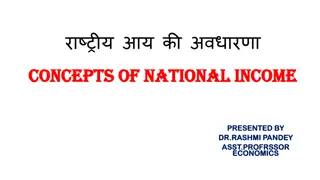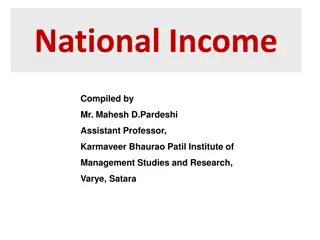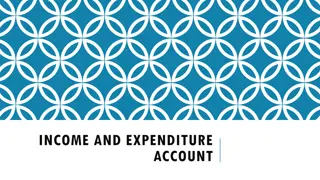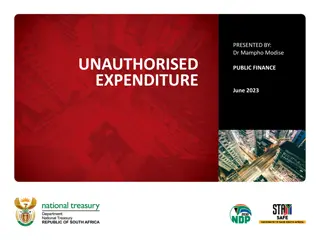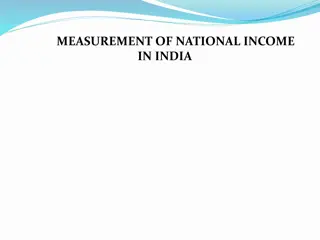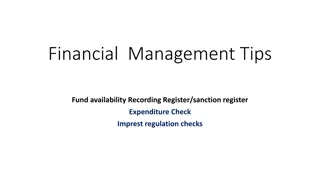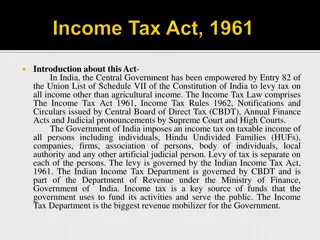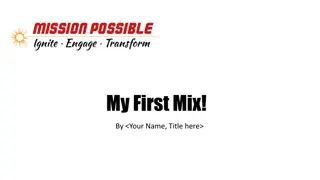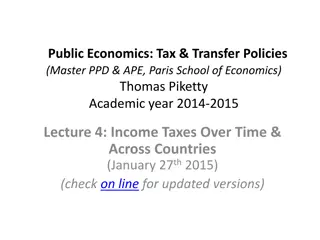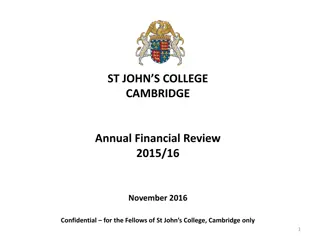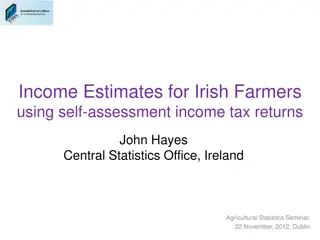Chapter 5: Recording Income and Expenditure
This chapter discusses the importance of maintaining financial records for households and businesses, outlining cash book entry rules, demonstrating cash book completion, balancing and totaling, interpreting opening and closing balances, and accounting for bank overdrafts. It covers reasons for keeping income and expenditure records, sources of information required, and details on the analyzed cash book columns and rules.
Download Presentation

Please find below an Image/Link to download the presentation.
The content on the website is provided AS IS for your information and personal use only. It may not be sold, licensed, or shared on other websites without obtaining consent from the author.If you encounter any issues during the download, it is possible that the publisher has removed the file from their server.
You are allowed to download the files provided on this website for personal or commercial use, subject to the condition that they are used lawfully. All files are the property of their respective owners.
The content on the website is provided AS IS for your information and personal use only. It may not be sold, licensed, or shared on other websites without obtaining consent from the author.
E N D
Presentation Transcript
Chapter 5 Learning intentions In this chapter you will learn to: Explain why households and businesses keep financial records Outline and demonstrate the rules that apply to cash book entries Complete an analysed cash book Balance and total an analysed cash book Explain the difference between opening and closing balances in an analysed cash book Interpret and evaluate an analysed cash book Account for opening and closing bank overdrafts in an analysed cash book. Textbook page reference: 44
Chapter 5 Why keep income and expenditure records? Financial records help keep track of actual income and expenditure, it also helps with financial planning and budgeting. Textbook page reference: 45
Chapter 5 Sources of information In order to write up an analysed cash book, the household needs to have accurate information about all the money it receives and spends, e.g. receipts and bank statements. Textbook page reference: 45
Chapter 5 The analysed cash book The analysed cash book is used to record all money actually received and spent. Textbook page reference: 46
Chapter 5 The rules The analysed cash book is divided into a debit (Dr) side and a credit (Cr) side. A debit is money received (income/receipts). A credit is money spent (expenditure/payments). Textbook page reference: 46
Chapter 5 The columns of the analysed cash book Date: The date of each transaction. Details: The reason the money was received or paid. Cash: The actual amount of cash received or spent. Bank: This column records all amounts received or paid through a bank account. Analysis columns: These columns are used for recording exactly where the income came from and what it was spent on. Textbook page reference: 46
Chapter 5 The columns of the analysed cash book Opening balances are labelled Balance b/d (b/d = brought down) in the account. Textbook page reference: 50
Chapter 5 Balancing and totalling accounts Closing balances are labelled Balance c/d (c/d = carried down). This tells us the amount of cash we have at the end of this accounting period. It will also be available at the start of the next accounting period. Textbook page reference: 48
Chapter 5 Balancing and totalling accounts The balance is the difference between the amounts of money on the debit and credit sides of an account. Textbook page reference: 48
Chapter 5 Balancing and totalling accounts Add up the amounts on each side and work out which has the biggest total. Write this amount in the total boxes. Underline all totals with a double line. 1 Calculate how much we need to add to the smaller side to make it equal to the total. Subtract the smaller figure from the bigger one. 2 Show the balance c/d on the smaller side. 3 Bring this balance across to the other side of the account. It appears as a balance b/d on the opposite side. 4 Textbook page reference: 49
Chapter 5 The benefits of keeping an analysed cash book You have a record of all income and expenditure. This record can be compared against your budget to make sure you are on track and find where you might have to revise. You can see where you might be overspending and adjust your habits to make sure that you stay within your budget. You can check your bank and credit card statements against what you have recorded to make sure that no mistakes have been made. Textbook page reference: 51
Chapter 5 Bank overdrafts A bank overdraft is an arrangement with the bank that allows an account holder to withdraw more money than they have in their current account. Textbook page reference: 51
Chapter 5 Accounting for a bank overdraft The Balance b/d for the bank account is on the credit side. This shows the bank account is overdrawn at the start of the week. Textbook page reference: 52
Chapter 5 Recap and review Can you? Explain why households and businesses keep financial records. Outline and demonstrate the rules that apply to cash book entries? Complete an analysed cash book? Balance and total an analysed cash book? Explain the difference between opening and closing balances in an analysed cash book? Interpret and evaluate an analysed cash book? Account for opening and closing bank overdrafts in an analysed cash book?
Chapter 5 Credit slide Shutterstock



